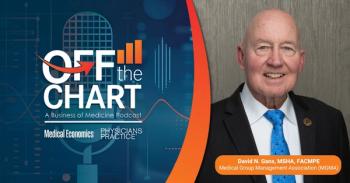
Overcoming Patient Logjams
A Los Angeles pediatrician thinks she doesn’t have enough time, but is lack of space her real problem?
Albert Einstein revolutionized physics when he theorized that space and time weren’t disconnected, but rather formed a continuum - the space-time continuum.
For a peek at space’s effect on time in medicine, walk into the crowded Los Angeles-area waiting room of pediatrician Sarah Harbor* on a weekday afternoon. You may not find space to sit. Instead, packed into the exam rooms and a small waiting area you’ll find parents and children who frequently wait an hour to be seen by Harbor or her part-time associate. “It stresses me out, because I want to be as efficient as possible,” says Harbor.
To de-stress, Harbor needs to adjust her practice’s space-time continuum. Tweaking the time element through smarter scheduling should offer partial relief. However, to achieve a comprehensive solution to sluggish patient flow, Harbor will have to address the issue of space as well. The practice’s three exam rooms are barely sufficient for one busy pediatrician, let alone two. Patients can’t get roomed quickly enough, and occasionally ensconcing them in the employee lounge or Harbor’s private office is at best a stopgap and at worst a HIPAA violation waiting to happen.
“There are too many pistons and not enough cylinders,” says La Jolla, Calif., practice management consultant Judy Bee. And Harbor’s 225-square-foot waiting room? Way undersized according to industry norms. The question is, how badly does Harbor want to lower her stress level? “This isn’t going to be a cosmetic makeover,” says Bee.
What’s causing the crunch?
Harbor’s office is open from 9 a.m. to 5 p.m. every weekday except Thursday, when it closes at noon. Harbor sees about 15 patients each morning, and 25 in the afternoon. Her associate, Sue Chaddington*, works from 1 p.m. to 5 p.m. on Monday, Wednesday, and Friday, treating about 12 patients a day.
Harbor needs all the help she can get during the afternoon, for those coveted after-school appointments. Adding to the crunch is tag-along syndrome, in which Mom makes an appointment for Juan, but arrives with Maria and Elisa in tow because she doesn’t have a babysitter. This entourage strains the 15-chair waiting room, but that’s not all. Mom often asks Harbor to give medical attention to Maria, even though Maria wasn’t scheduled for an appointment. It’s a formula for frustration that Einstein would have admired for its explosive potential.
Harbor can blunt the effects of tag-along syndrome by declining to treat impromptu patients on a hectic day unless they have an acute problem like an ear infection, says Bee. Tag-alongs who need, say, a school physical or an evaluation for hyperactivity should be scheduled for another day unless a no-show or cancellation makes room for them. Bee recommends a gentle but to-the-point explanation along the lines of, “Doing a good job on X takes time - and I’m sorry, we don’t have it today, given how full the schedule is. How about if we book an appointment for this?”
If you are able to work the tag-along into the day’s visit, remember that because you’ve seen two patients, you should be billing for two services. And, of course, making notes in two records and collecting two copays.
That said, pediatricians like Harbor should leave open as many late-afternoon slots as possible for the same-day appointments and walk-ins that invariably materialize. In other words, book the majority of well-child appointments and follow-up visits in the morning and early afternoon so late afternoons don’t become congested. Figure out the ideal number of slots for your practice to leave open by tracking demand (not appointments actually booked) on a simple spreadsheet over the course of a couple of weeks.
Staggered shift benefits
Afternoons might decompress further if Harbor worked Thursday afternoon and spread out the week’s load of patients, says consultant Gray Tuttle, of Lansing, Mich. “She’s working 31 hours a week in the office, which is below average for pediatricians,” he says. But Harbor, who begins hospitals rounds at 7 a.m. every day, understandably cherishes her Thursday afternoon hiatus. “I need time to catch up on paperwork - and my life,” she says.
There’s one way to preserve her down time, however, and overcome the exam-room shortage in the process. Harbor could extend office hours to 8 p.m. on Monday, Wednesday, and Friday and stagger the physician schedules - 9 a.m. to 4 p.m. for herself, and 4 p.m. to 8 p.m. for Chaddington. If she then worked from 9 a.m. to 5 p.m. on Tuesday and Thursday, she’d only log one more hour per week than she currently does. And she and Chaddington wouldn’t have to share the three exam rooms.
Harbor isn’t convinced this plan would succeed. Almost half of her patients are covered by some form of state safety-net insurance program, she says, and many of them arrive at the office by bus or on foot. Their parents would be less inclined to see her on winter evenings when it gets dark early. And her three employees can’t work at night due to family obligations, Harbor says.
Tuttle begs to differ. “When you have a sick kid, you’ll see a doctor any time you can,” he says. And certainly Harbor can find some eager job seeker to work a late shift, he adds. “In this economy,” notes Bee, “she’d probably find her staff to be more flexible.” This is not to say that Harbor must take a hard line with her employees, but perhaps the time has come to explore alternative options, such as job sharing, that can better accommodate her scheduling needs.
Space - the final frontier
Bee and Tuttle agree that Harbor’s best solution for easing the practice’s cramped quarters is moving into more spacious digs (there’s no room for expansion in her current building). To handle her existing patient load, Harbor needs not only six exam rooms for the days when she and her associate are both scheduled, but also a much larger waiting room. Tuttle does the math. When both doctors are working, they see eight patients per hour. With a parent for each child, plus the inevitable tag-along child or two, the office can expect a likely per-hour visitor count of 24 (eight appointments times three). Subtract the number of exam rooms from the visitor count of 24, and you have the number of needed waiting-room chairs: in this case 21. To arrive at the total square footage required, multiply 21 chairs by 20 square feet. The answer, based on those industry guidelines, is a 420-square-foot waiting room, almost double what Harbor has now.
All told, Harbor should look for an office with roughly twice her current square footage of 1,200, says Tuttle. “Anything short of that, and she’s putting a Band-Aid on the problem.” In the meantime, he says, Harbor should consider converting her private office to an exam room and creating a hallway workstation instead.
The prospect of doubling her office footprint might appear unaffordable, but Harbor should be able to find dirt-cheap space in a depressed real estate market. Bee suggests that Harbor consider relocating to a strip mall because these spaces typically charge less rent than professional office buildings. True, remodeling and new furnishings probably will cost $50,000 to $70,000, estimates Tuttle, but he believes a bank would lend Harbor the money, even in this troubled economy. And she could more quickly recoup her investment by going from a part-time to a full-time associate, a move that takes maximum advantage of the extra space. Even better - from a strictly bottom-line point of view - hire a full-time nurse practitioner, says Tuttle. “An NP can produce more profit for Harbor than an associate.”
Supersizing the office is a dramatic makeover indeed, but there’s no other good long-term solution, our experts say. “There are two doctors in a one-doctor space,” says Bee. “You can’t deny reality.” Or the space-time continuum in medicine.
*Names have been changed.
Robert Lowes is an award-winning journalist who has covered the healthcare industry for 20 years. He also is a published poet with an MFA in creative writing. He can be reached via
This article originally appeared in the October 2009 issue of Physicians Practice.
Newsletter
Optimize your practice with the Physicians Practice newsletter, offering management pearls, leadership tips, and business strategies tailored for practice administrators and physicians of any specialty.










